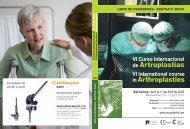cadera / hip - Active Congress.......
cadera / hip - Active Congress.......
cadera / hip - Active Congress.......
You also want an ePaper? Increase the reach of your titles
YUMPU automatically turns print PDFs into web optimized ePapers that Google loves.
VIERNES / FRIDAY<br />
296<br />
Inc, Warsaw, IN) was used in 395 patients<br />
(421 TKA) including 271 revision (65%),<br />
reimplantation in 90 (21%), conversion in 11<br />
(3%), complex primary in 47 (11%), and total<br />
femur replacement in 2 (0.5%). Indications<br />
for revision were aseptic loosening in 169<br />
(62%), instability in 45 (17%), arthrofi brosis<br />
in 20 (7%), pain in 13 (5%), periprosthetic<br />
fracture in 11 (4%), malalignment in 6, crepitus<br />
in 3, extensor mechanism dysfunction in<br />
3, and component breakage in 1. Etiology<br />
for complex primary was osteoarthritis in 26<br />
(55%), rheumatoid in 13 (28%), and posttraumatic<br />
in 8 (17%). Follow-up in living patients<br />
averaged 5 years. Knee Society clinical score<br />
improved from 48 to 79, range of motion<br />
improved from 91 degrees to 101 degrees.<br />
Overall survivors<strong>hip</strong>, is 89%. Survivors<strong>hip</strong><br />
with aseptic revision as the endpoint is 94%.<br />
Revision for sepsis was required in 23 knees<br />
(5%). Of these infections, 9 were recurrent in<br />
the series of 90 reimplantation cases (10%)<br />
and 14 occurred in the 331 knees without<br />
history of infection (4%). Indications for constraint<br />
are reviewed.<br />
THE ROLE OF STEMS<br />
IN REVISION TKA<br />
C. H. Rorabeck, MD<br />
Health Sciences Centre<br />
London - Ontario, Canada<br />
Background:<br />
It is safe to use hybrid fi xation (cementless<br />
stems/cemented articular components) when<br />
performing revision TKA with a varus/valgus<br />
constrained device.<br />
Methods:<br />
110 revision total knee replacements were<br />
performed in 107 patients in a single centre<br />
prospective study using revision intramedullary<br />
stems and a highly constrained polyethylene<br />
insert between 1193 and 1999. All<br />
patients received cemented metaphyseal<br />
components and either a cemented or uncemented<br />
revision intramedullary stem. Seventy<br />
of these patients received uncemented<br />
stems in both the femur and the tibia and<br />
were considered as having “hybrid fi xation”<br />
and were the focus of our study. All 70 of<br />
these patients had complete clinical and<br />
radiographic evaluation.<br />
Results:<br />
There were 9 (12.9%) re-revisions: 3 (4.3%<br />
for aseptic loosening, 2 (2.9%) for recurrent<br />
infection and 4 (5.7%) for instability. The 61<br />
remaining patients were followed for a mean<br />
of 5.1 years (range 2 to 10 years). There was<br />
a 4.3% rate of aseptic loosening and Kaplan-<br />
Meier survivors<strong>hip</strong> of 86.9% at 6.3 years for<br />
all revisions. Signifi cant improvements in<br />
pain scores (18 to 42, p





